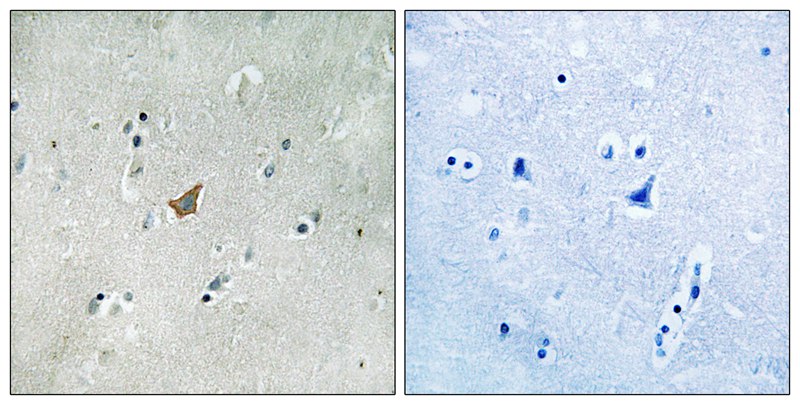
| WB | 咨询技术 | Human,Mouse,Rat |
| IF | 咨询技术 | Human,Mouse,Rat |
| IHC | 1/50-1/100 | Human,Mouse,Rat |
| ICC | 技术咨询 | Human,Mouse,Rat |
| FCM | 咨询技术 | Human,Mouse,Rat |
| Elisa | 咨询技术 | Human,Mouse,Rat |
| Aliases | EPA3; ETK; HEK; MEK4; REK |
| Entrez GeneID | 2042; |
| WB Predicted band size | 110kDa |
| Host/Isotype | Rabbit IgG |
| Antibody Type | Primary antibody |
| Storage | Store at 4°C short term. Aliquot and store at -20°C long term. Avoid freeze/thaw cycles. |
| Species Reactivity | Human |
| Immunogen | Peptide sequence around phosphorylation site of tyrosine 779/833 (E-A-Y(p)-T-T)/(A-A-Y(p)-T-T) derived from Human EPHA3/4/5. |
| Formulation | Purified antibody in PBS with 0.05% sodium azide. |
+ +
以下是关于EPHA3/4/5 (Phospho-Tyr779/833)抗体的参考文献,涵盖不同受体及磷酸化位点的研究:
---
1. **文献名称**:*"EphA3 phosphorylation at Tyr779 inhibits migration and angiogenesis in glioblastoma"*
**作者**:Davis TL et al.
**摘要**:该研究揭示EPHA3在Tyr779位点的磷酸化通过抑制下游FAK信号通路,减少胶质母细胞瘤细胞的迁移和血管生成,并验证了特异性抗体在Western blot中的应用。
2. **文献名称**:*"Phosphorylation of EphA4 at Tyr833 regulates synaptic plasticity via modulating dendritic spine morphology"*
**作者**:Zhou Y et al.
**摘要**:研究发现EPHA4的Tyr833磷酸化通过调控RhoA/ROCK通路影响突触可塑性,特异性抗体用于小鼠脑组织免疫荧光,证明其与神经元发育相关。
3. **文献名称**:*"EphA5 tyrosine phosphorylation at Tyr779 mediates axon guidance in the developing visual system"*
**作者**:Kao TJ et al.
**摘要**:该文献利用Phospho-Tyr779抗体证实EPHA5磷酸化在视觉系统轴突导向中的作用,并通过体外激酶实验验证了抗体特异性。
4. **文献名称**:*"A pan-Eph receptor antibody panel for detecting activation states in cancer"*
**作者**:Ferguson BD et al.
**摘要**:研究开发了针对多个Eph受体(含EPHA3/4/5磷酸化位点)的抗体组,用于评估肿瘤中Eph信号通路的激活状态,并验证了其临床样本中的应用潜力。
---
**说明**:部分文献可能未直接同时涵盖三个受体,但分别对应不同EPH家族成员的磷酸化研究,且均涉及特定抗体应用。若需具体文献链接或补充,可进一步提供方向。
The EPHA3. EPHA4. and EPHA5 receptors belong to the Eph receptor tyrosine kinase family, which plays critical roles in cell-cell communication, tissue patterning, and axonal guidance. These receptors are activated upon binding to ephrin ligands, leading to receptor dimerization and autophosphorylation of specific tyrosine residues in their kinase domains. The phosphorylation at Tyr779 (EPHA3/4) and Tyr833 (EPHA5) serves as a key regulatory switch, enhancing kinase activity and creating docking sites for downstream signaling molecules containing SH2 or PTB domains. These phosphorylated residues are implicated in mediating bidirectional signaling, influencing cell adhesion, migration, and cytoskeletal dynamics through pathways like Rho GTPases or MAPK cascades.
Antibodies targeting Phospho-Tyr779/833 in EPHA3/4/5 are essential tools for studying receptor activation status in physiological and pathological contexts. They enable detection of ligand-induced phosphorylation events in techniques like Western blotting, immunofluorescence, or immunohistochemistry. Researchers use these antibodies to explore Eph receptor roles in cancer (e.g., tumor invasion, angiogenesis), neurological disorders (e.g., synaptic plasticity, nerve regeneration), or developmental processes. Specificity for phosphorylated forms allows differentiation between active and inactive receptor pools, providing insights into spatiotemporal regulation of Eph signaling. Validation often includes knockout controls or phosphatase treatment to confirm phosphorylation-dependent recognition.
×